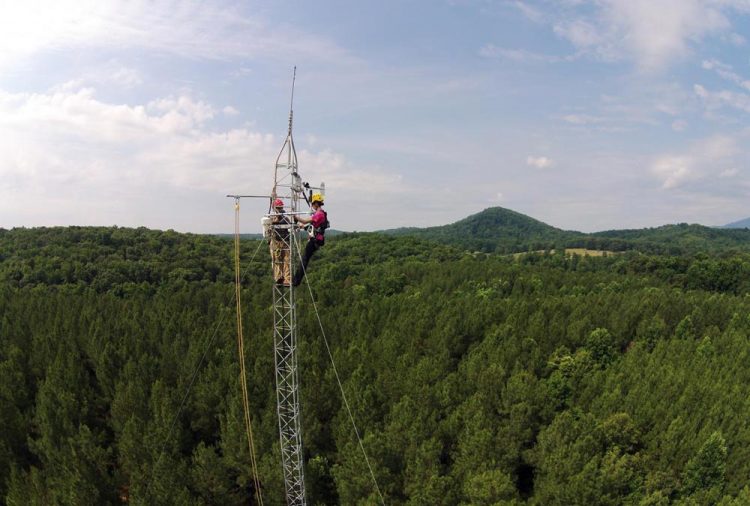New research unlocks forests' potential in climate change mitigation

Clemson University scientist Thomas O'Halloran works atop a 120-foot tower. Credit: Rob Alexander
For the first time, scientists have created a global map measuring the cooling effect forests generate by regulating the exchange of water and energy between the Earth's surface and the atmosphere. In many locations, this cooling effect works in concert with forests' absorption of carbon dioxide.
By coupling information from satellites with local data from sensors mounted to research towers extending high above tree canopies, O'Halloran and his collaborators throughout the world have given a much more complete, diagnostic view of the roles forests play in regulating climate.
Their findings have important implications for how and where different types of land cover can be used to mitigate climate change with forest protection programs and data-driven land-use policies. Results of their study were recently published in the journal Nature Climate Change.
“It's our hope that such global maps can be used to optimize biophysics in addition to carbon when planning land-use climate change mitigation projects,” said O'Halloran, assistant professor of Forestry and Environmental Conservation at Clemson's Baruch Institute of Coastal Ecology and Forest Science in Georgetown.
Previously, scientists measured vegetation's impact on local land temperatures using satellite imagery, which is limited to only clear-sky days and few measurements per day, or they used local stations, which are limited in their reach. Integrating data from towers extending more than 100 feet in the air with satellite measurements allows for a more advanced view of the variables impacting surface temperature. The research team found that forests' cooling effect was greater than thought and most pronounced in mid- and low-latitude regions.
This new statistical model of analyzing forests' impact on local temperature will allow communities around the world to pinpoint ideal locations for forest protection or reforestation efforts.
“We wanted every country in the world to have some estimation of the cooling effects of forests and vegetation,” O'Halloran said. “It's about optimizing the benefit of land management for climate change mitigation.”
A tower similar to those used for this study is under construction at Baruch in collaboration with the University of South Carolina to help provide greater analysis of local climate, he said.
“The towers will really help us understand how ecosystems respond to change,” O'Halloran said. “In South Carolina, we've had a lot of extreme weather events, droughts, flood and hurricanes. This will help us understand the resilience of local ecosystems to those types of events.”
O'Halloran co-authored the article in Nature Climate Change with lead author Ryan Bright of The Norwegian Institute of Bioeconomy Research in Norway and several additional collaborators throughout Europe and the United States.
Unlike local climate changes owed to global emissions of CO2 and other greenhouse gases, local climate changes linked to land-related activities are unique in that they are only influenced by the local land-use policies that are in place, Bright said.
“The results of our study now make it easier for individual nations or regions to begin measuring and enforcing climate policies resulting in tangible mitigation or adaptation benefits at the local scale,” says Bright. “This is especially critical moving forward in a world facing increasing competition for land resources.”
###
Other research collaborators were Edouard Davin of the Institute for Atmospheric and Climate Science in Switzerland; Julia Pongratz of the Max Planck Institute for Meteorology in Germany; Kaiguang Zhao of the School of Environment and Natural Resources at The Ohio State University; and Alessandro Cescatti of the European Commission's Joint Research Centre in Italy.
Media Contact
All latest news from the category: Earth Sciences
Earth Sciences (also referred to as Geosciences), which deals with basic issues surrounding our planet, plays a vital role in the area of energy and raw materials supply.
Earth Sciences comprises subjects such as geology, geography, geological informatics, paleontology, mineralogy, petrography, crystallography, geophysics, geodesy, glaciology, cartography, photogrammetry, meteorology and seismology, early-warning systems, earthquake research and polar research.
Newest articles

Innovative vortex beam technology
…unleashes ultra-secure, high-capacity data transmission. Scientists have developed a breakthrough optical technology that could dramatically enhance the capacity and security of data transmission (Fig. 1). By utilizing a new type…

Tiny dancers: Scientists synchronise bacterial motion
Researchers at TU Delft have discovered that E. coli bacteria can synchronise their movements, creating order in seemingly random biological systems. By trapping individual bacteria in micro-engineered circular cavities and…

Primary investigation on ram-rotor detonation engine
Detonation is a supersonic combustion wave, characterized by a shock wave driven by the energy release from closely coupled chemical reactions. It is a typical form of pressure gain combustion,…



